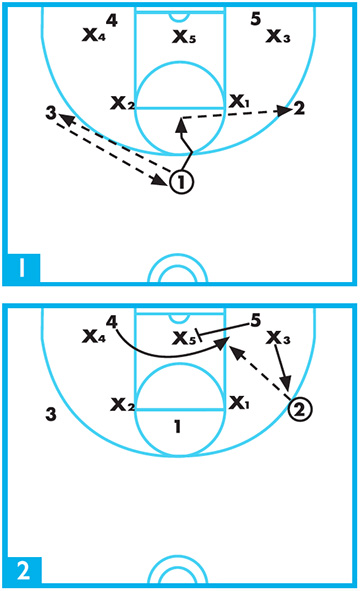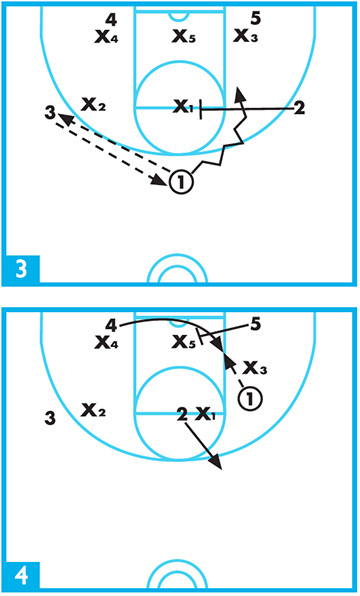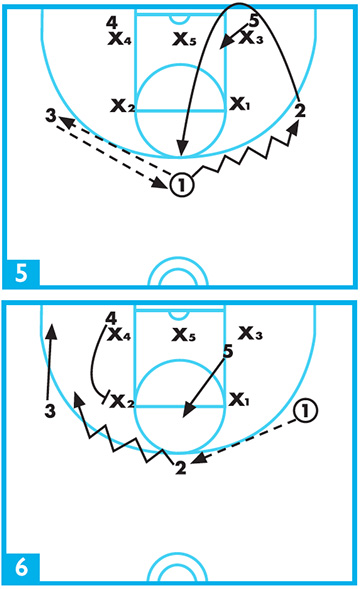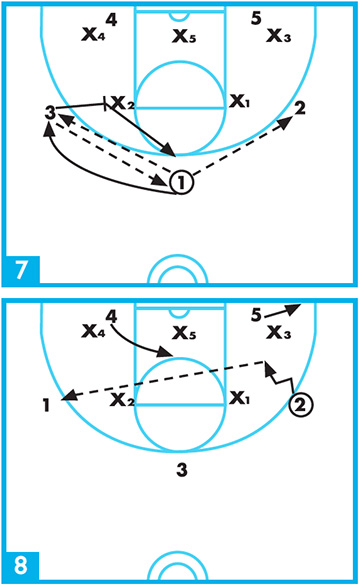5 quick hitters to shred zone defenses
Attacking zone defenses is nothing new to the world of basketball. Many coaches, myself included, have used continuity offenses, alternating fronts, attacking from the short corner, high-low attacks, screening and much more.
During the last few years, I added quick hitters to my team’s offensive arsenal, and it has improved our ability to score against and exploit zone defenses. Here are five quick hitters from a basic three-out, two-in zone attack. All five plays can be run from a two-guard front with little variation. Running a standard zone attack, then adding these quick hitters, helps shred zone defenses.
Try utilizing these plays when your offense becomes stagnant, a possession gets within 15 seconds of the shot clock, or you want to exploit a mismatch or weakness of the zone.
 ‘Thumbs Up’
‘Thumbs Up’
The “Thumbs Up” quick hitter yields an easy basket in the paint against any zone. Start in a three-out set, with the two interior players in the short-corner area on opposite sides of the court. Before jumping into the play, the ball always is passed from point to wing, and back from wing to point to shift the defense. The play is run to the opposite side of the court from where you sent the initial pass.
DIAGRAM 1: Thumbs Up (A). On the return pass from 3, 1 takes a dribble to attack the middle of the zone and draw X1 to the paint. This is called a “freeze dribble,” which freezes the zone. 1 jump-stops and passes to 2 on the wing. 2 fakes a shot on the catch to try to entice X3 and X1 to challenge the shot.
DIAGRAM 2: Thumbs Up (B). 5 sprints to the middle of the paint and screens X5. After the screen, 5 pivots and seals X5 to gain strong post position. 5 demands the ball if he gets position. 4 uses 5’s screen and reads whether to go over or under the screen to receive a pass from 2. Either 4 or 5 (in this case, 4) is open for a shot.
 ‘Thumbs Down’
‘Thumbs Down’
“Thumbs Down” is similar to “Thumbs Up” and is designed to score in the paint. Both are a great alternative to an offense’s typical zone attack — the 3-point shot.
DIAGRAM 3: Thumbs Down (A). On the return pass from 3 to 1, 2 comes across and sets a ball screen on X1. 1 dribbles off the screen and turns the corner to force X3 to match up.
DIAGRAM 4: Thumbs Down (B). 5 sprints to the middle of the paint and screens X5. After the screen, 5 spins and seals X5 to gain strong post position. He then demands the ball if he has position. 4 uses 5’s screen and reads whether to go over or under the screen to receive a pass from 1. In this example, 4 goes under. Either 4 or 5 is open for a shot in the paint.
 ‘Circle’
‘Circle’
“Circle” creates perimeter player movement and adds ball-screen action to the zone attack. The play is designed to get 2 a shot at the top of the key. Other options include using the ball screen to establish the pick-and-roll, or finding 3 spotting up for a 3-pointer in the corner. Start in a three-out, two-in set with 1 passing to 3, and 3 passing back to 1.
DIAGRAM 5: Circle (A). On the return pass from 3, 1 dribbles to the opposite wing and faces up to attack the basket from the wing. 2 sprints to the baseline, then cuts up the lane and replaces 1 at the top of the key. 2 looks for an open shot and needs to find the gap in the defense. 5 flashes to the block to occupy the defense or potentially score after receiving a post entry pass.
DIAGRAM 6: Circle (B). 1 passes to 2 at the top of the key for a possible shot. 4 sets a ball screen on the top defender in the zone to create a pick-and-roll game with 2. 2 attacks the basket, shoots, or feeds 4 rolling to the hoop. Another option is passing to 3 moving to the corner.
 ‘Over’
‘Over’
“Over” is designed to get 1 an open 3- pointer from the wing. Also, try to incorporate a handoff or some player movement (repositioning) to find a shot for a different player.
Start in a three-out set with the two interior players in the short corners on opposite sides. 1 passes to 3, and 3 passes back to 1. To add some player movement, think about running the first part of “Circle” (Diagram 5), then go immediately into “Over.”
DIAGRAM 7: Over (A). 1 passes to 2. 3 sets a solid backscreen on the top defender in the zone (or the wing of a one-guard-front zone). 1 runs a flare-cut to the opposite wing of where he passed. 1 spots up for a 3-pointer. 3 holds his screen as long as possible, then cuts to the top of the key.
DIAGRAM 8: Over (B). 2 attacks the basket with the dribble and looks to fire a skip pass to 1 for a shot. 4 looks for the gap in the lane and tries to find a scoring seam. 5 steps to the short corner on 2’s penetration. 3 spots up for a jumper at the top of the key after releasing the screen.
 ‘Shallow’
‘Shallow’
“Shallow” incorporates a shallow cut and quick ball movement to create a scoring opportunity for a perimeter player. There also may be an opportunity to use a high-low attack within if the defensive shifts and leaves an opening. Start in the three-out, two-in set with 1 passing to 3, and 3 passing back to 1.
DIAGRAM 9: Shallow (A). On the return pass from 3 to 1, 1 dribbles to the opposite wing. 2 runs a shallow cut to the opposite wing, and 3 replaces 1 at the top. 5 can flash the post to score, or occupy the defense.
DIAGRAM 10: Shallow (B). 1 fakes a shot, then swings to 3 at the top of the key. 3 makes a quick swing and reverses the ball to 2 on the other wing. 2 should have an open shot. 4 sprints to the middle of the lane and posts up the center defender. 5 flashes high for a shot or a high-low opportunity.
These five plays help add to your offensive variety when attacking a zone. They’re effective when screening the zone, attacking the zone while shifting, and using various cuts and movement. Make sure your players play zone during practice to get a better understanding of its concepts. Also, practice against various zones and add in some of these quick hitters to find good scoring opportunities against multiple zone defenses.
Chad Kish is a former assistant men’s basketball coach and associate professor of physical education at Mineral Point College in Missouri.









